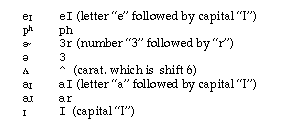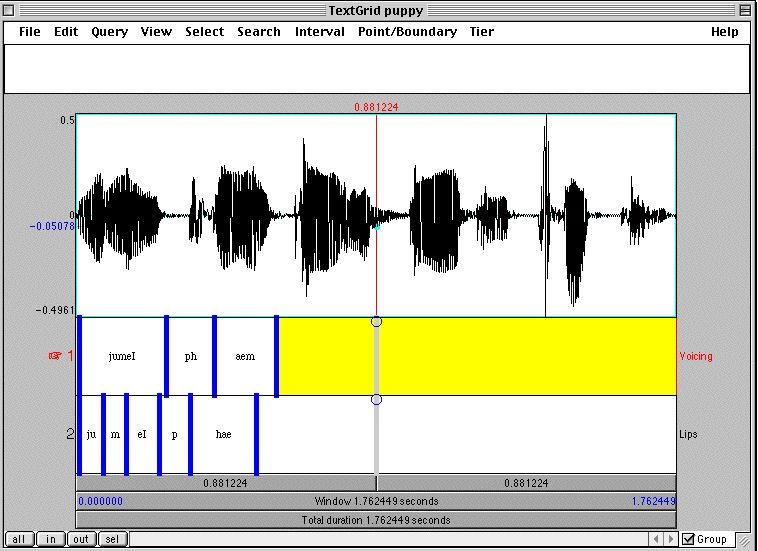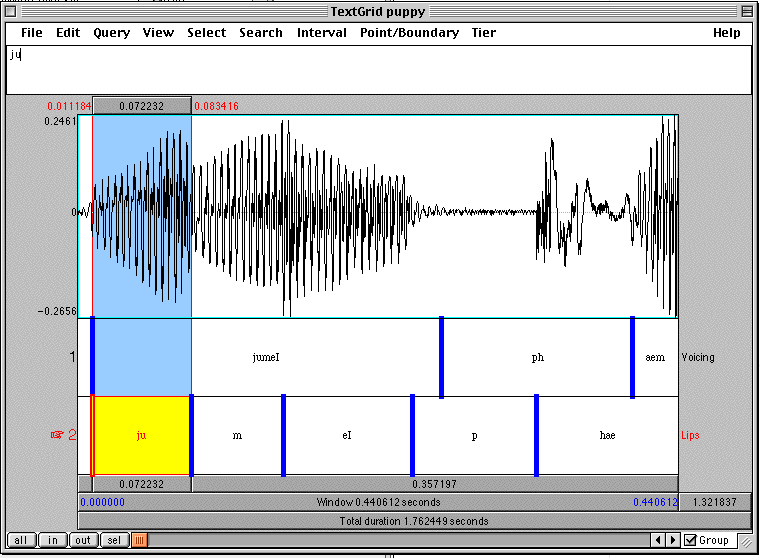Linguistics 580
General Phonetics
The exercise involves examining the acoustic waveform of utterances using Praat. The goal is to learn to identify intervals where there is a closure in the vocal tract, and to be able to distinguish voiced from voiceless intervals. The utterances to be examined are as follows :
(1) "You may pamper a baby puppy."
(2) "He started to tidy it."
The acoustic waveforms are to be segmented in two way:
In addition, you will assign labels to each interval indicating, roughly, those symbols of the narrow phonetic transcription of the sentence that correspond to that interval.
The narrow transcription of sentence (1) is as follows (ignoring stress):
To accommodate use of a standard (non-phonetic) font, make the following substitutions in your label names:

Thus, the narrow transcription of sentence (1) becomes:
This narrow transcription is a bit misleading, as it assumes that all voiceless stops are aspirated, which they are not. They vary considerably in the amount of time from the oral release to onset of voicing, but it is useful to have available the h available as a separate symbol in the transcription. You should treat it as representing the interval of time between the release of an oral stop and the onset of voicing (the voice onset time). Thus, when assigning symbols of the transcription to the closed/open segmentation, assign h to an open interval. For the voiced/voiceless segmentation, assign h to a voiceless interval.
Download the file Segmenting.Collection by right-clicking here.
Open the file Segmenting.Collection in Praat. There should be 4 Praat objects created: Sound puppy, Textgrid puppy, Sound tidy, and Textgrid tidy. Select the Sound and Textgrid objects for puppy (by holding the shift key while clicking on the object names), and click on Edit on the right side of the Praat Objects window. A window like that in Figure 1 should appear:

The waveform form for sentence (1) is shown in the top panel. Below it are two text grid tiers for labelling. the top one (Voicing) segments the waveform into intervals correpsonding to successive voiced and voiceless intervals, the bottom one (Lips) segments the waveform into successive intervals in which the Lips are open or closed. The beginning of this utterance has been done for you.
Before doing anything else, change the horzontal zoom so you can see sufficient temporal detail to segment the signal. To do so, click twice on the zoom in button in the lower left corner of the window. You should now see a total of about .44 seconds in the window.
To begin to examine the data, move the slider at the bottom of the window all the way to the left so that you are looking at the beginning of the utterance. Click in the first interval of the Lips tier (labelled ju) . You should now see a display like that in Figure 2.

In general, intervals when the vocal tract is completely obstructed by a closure gesture will have acoustic amplitudes that are considerably lower than intervals when the vocal tract is not closed. In fact, if the closure is also produced with a closed velum (no nasalization) and an open glottis (voicelessness), the waveform will show complete silence. If there is voicing, but no nasalization, a very low amplitude periodic waveform may be seen. If the closure is both voiced and nasalized, the periodic waveform will show considerable amplitude, but still lower than intervals when the mouth is open.
At the beginning of sentence (1), the vocal tract is open, and it remains open until the closure of the lips for the [m] in "may." The first interval on the Lips tier (highlighted in Figure 1) begins at the beginning of the sentence and ends when the closure for the [m] is achieved. Confirm this for by listening to the interval (click on the playbar just beneath the ju interval). Finding the beginning of a nasal closure is a bit more difficult that finding an oral one, because the amplitude doesn't decrease by as much. Nonetheless, when you look at the waveform at the time scale shown in Figure 2, you can clearly see a relatively abrupt amplitude change that corresponds to the time at which the lips become completely sealed. Now select the next inteval, labelled m. The waveform should correspond to the closure interval of the Lips for the /m/. Confirm this for by listening to the interval (click on the playbar just beneath the m interval). There is another abrupt discontinuity of the waveform at the release of the /m/. Select the next interval that extends from the release of the /m/ to the next lip closure--that for /p/. Listening to this interval should sound like /beI/ or /meI/ (because you can hear the lips open from the insant of release to time at which they are completely open. Continue and examine the next intervals, closed (p ) and open (hae). Note that the beginning of the closure interval for /p/ contains some voiced closure (but we will not bother transcribing that with a separate symbol). Note that the beginning of the open interval after the release of the /p/ is voicless and voicing begins at some point later during this voiceless interval. Now select the next closed interval after the open interval of /hae/. You will have to use the bottom slider to scroll the display over. The beginnning of the closure interval is already done for you--it is the right edge of the hae interval. Use the cursor to find the release of the closure interval (listen to section of window before and after cursor, using playbars, to check if your location is correct). When you have located the release, click on the little button on the cursor at the top of the Lips tier. A new interval boundary will be placed in the Lips tier. Click on the new interval you have created, and label it mp. Continue with the rest of utterance.
When you have labeled one or two intervals, you will want to save your work (so you don't lose it). Select puppy.Textgrid in the Praat object list, go to the Write menu and select Write to text file.... Save it as <your name>_puppy.Textgrid.
When you have completely finished labeling closure and open intervals of sentence (1), and have saved your work, now you are ready to label the voiced and voiceless intervals. Switch to the Voicing tier (by clicking in it) and scroll back to the beginning of the sentence. Note that the first two intervals are already done for you.
In general, during voiced intervals, you will see a regular periodicity in the acoustic signal, that will have a fundamental frequency somewhere between 100 Hz and 300 Hz. During voiceless intervals, this periodicity is not seen.
If we assume that the interval between release of a stop and the onset of voicing has to be greater than 40 milliseconds to count as "aspirated," which of the stops in sentence (1) are aspirated? Please email me a list of which /p/s are aspirated.
Follow the same procedure for sentence (2) (tidy) . Here you will have to provide your own transcription, and there are no examples. Sentence (2) includes a fricative. Include the frication interval with the closure interval of the following stop. Also, please email me a list of which /t/s are aspirated.
When all files are completed, email me <your_name>_puppy.TextGrid and <your_name>_tidy.TextGrid. Or select all files, choose Write to binary file... from the Write menu, and call it <your_name>_seg.Collection, and email that to me.